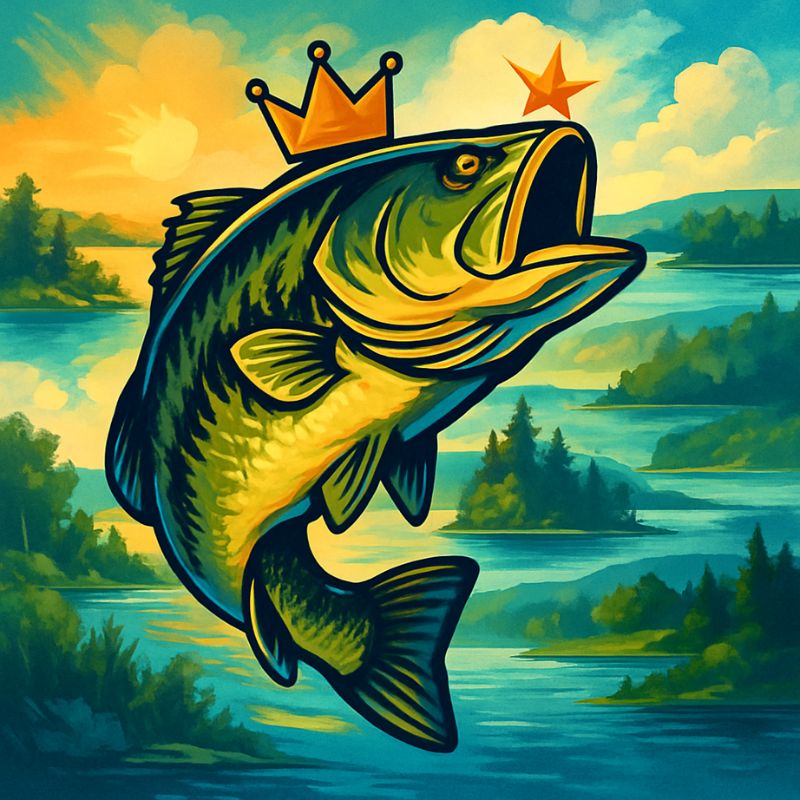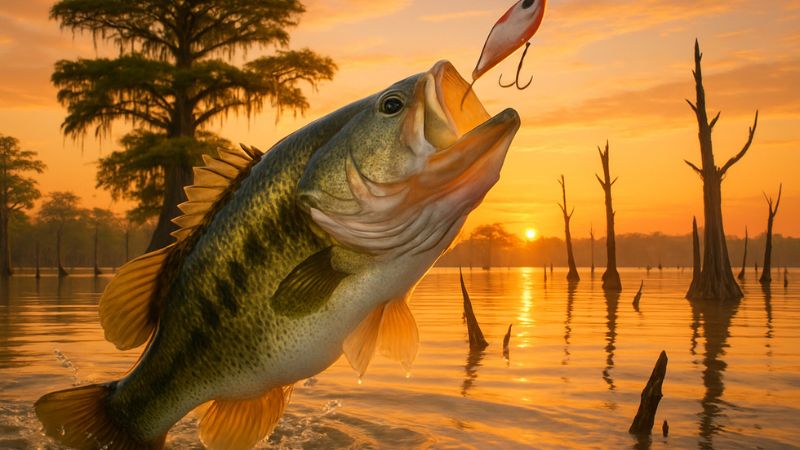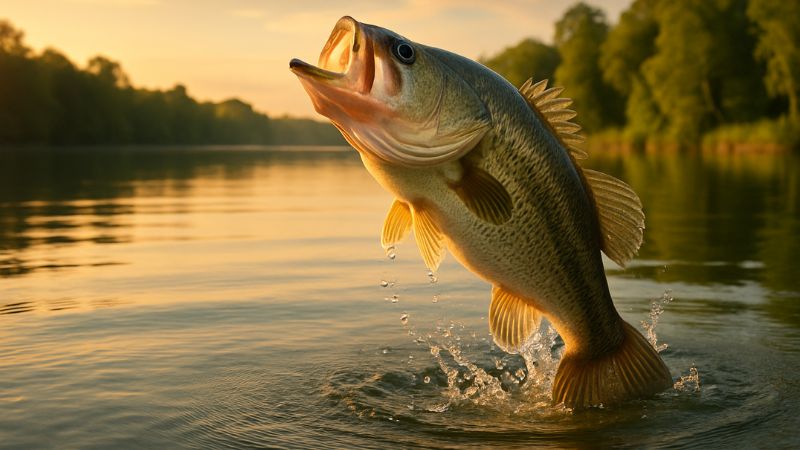The Best Places to Catch a Trophy: Top 10 Lakes for Trophy Bass Fishing
When you think of bass fishing, what comes to mind? Is it a quiet day on the water, a peaceful morning casting a line? For many anglers, it’s all about the hunt for a trophy-sized bass. We’re talking about a fish so big it might take two hands to hold, a largemouth bass that makes a memorable photograph. Catching a trophy-sized bass is a goal for many people, and it takes a mix of skill, patience, and, most importantly, knowing where to go. While there are countless reservoirs and lakes with largemouth bass, some are known for producing truly giant fish.
This guide is for anyone who dreams of that big catch. We’re going to walk you through some of the most famous bass lakes in the country, places where the odds of hooking a monster are higher than anywhere else. We’ll give you an inside look at what makes each of these lakes so special, and we’ll even give you some tips on how to fish them. From the warm waters of Florida to the cooler regions of the north, we’ve got you covered.
10 Best Bass Fishing Lakes List: Where to Find Your Next Monster Bass
These are the places that get talked about in Bassmaster Magazine and on shows like Bass CastPRO. These lakes are where Bassmaster Elite Series pros go to compete and where amateur anglers go to make their dreams come true. Let’s get to the list.

Lake Fork, Texas: A Bass Paradise
When you think of a Texas bass fishery, Lake Fork is likely the first place that comes to mind. Located in East Texas, this largemouth bass lake has a long history of producing some of the biggest fish in the world. It’s a well-known fact that this lake is a giant-fish machine, with its own ShareLunkers program to prove it.
- Why it’s a trophy hotspot: The reason Lake Fork is so good is a combination of things. The fisheries department has kept strict slot limits for a long time. This means that a lot of largemouth bass are kept in the lake and get a chance to grow. The lake also has a lot of underwater structure, like submerged timber, roadbeds, and creek channels, which gives the big bass plenty of places to hide. The lake is also filled with baitfish, so the bass have a lot to eat. The ShareLunker program’s records on this lake are a powerful case study, proving its ability to produce giant bass year after year.
- Best time of year to visit: Spring is a favorite time for anglers as the big bass are moving into the shallows to spawn.
- Top fishing techniques: Many anglers here use big swimbaits or jigs to get a reaction bite from the biggest bass. The key is to fish slowly and methodically around all the sunken wood.

Lake Guntersville, Alabama: The Angling Attraction
This Alabama lake is a staple on the Bassmaster Elite Series circuit for a reason. Lake Guntersville has everything a trophy largemouth bass needs to grow big.
- Why it’s a trophy hotspot: What makes Guntersville special is the massive amount of submerged grass, or hydrilla, that provides perfect cover for fish. This creates a healthy ecosystem where baitfish, like shad, hide, and the big bass lie in wait.
- Best time of year to visit: The summer and fall are great times to fish here, as the bass are feeding heavily in the thick grass.
- Top fishing techniques: Power fishing is the name of the game here. Use big crankbaits that dig into the grass or a trolling motor to move through the thick cover with a jig.
Lake Okeechobee, Florida: The Bass Crown Jewel
No list of great bass lakes is complete without Lake Okeechobee. This massive body of water in Florida is known for producing some of the biggest Florida bass in the world. Its fame is recognized by everyone from professional anglers to the most casual fishermen.
- Why it’s a trophy hotspot: The warm weather in Florida allows fish to feed and grow year-round. Lake Okeechobee has a rich mix of shallow, grassy areas and deep open water, providing different types of habitats for the fish. The TrophyCatch program in Florida also helps track the number of big bass, and many of the biggest are caught here. The program’s website features data on the number of “Hall of Fame” and “Legacy Class” bass, with many coming from Lake Okeechobee.
- Best time of year to visit: The best time to catch a trophy-sized bass here is in late winter and early spring when they move to the shallow water to spawn.
- Top fishing techniques: Flipping and pitching jigs into the thick grass and reeds is a popular method. You can also use big, loud baits to get the bass to strike.
Toledo Bend, Straddling Two States (Texas & Louisiana)
This lake is a giant, and its reputation as a big bass lake is just as large. Toledo Bend is one of the most productive lakes in the country.
- Why it’s a trophy hotspot: Its sheer size means there is plenty of room for all kinds of structure, from deep points to standing timber. This gives big bass plenty of places to hide from fishing pressure.
- Best time of year to visit: You can catch big bass here year-round, but spring is a favorite time for many anglers.
- Top fishing techniques: Big jigs and deep-diving crankbaits are very popular. Many anglers also use their sonar to find schools of baitfish and the bass nearby.
Clear Lake, California: California’s Bass Haven
Clear Lake in California is often called the “Bass Capital of the West.” It’s a shallow lake that produces a huge number of Largemouth bass, and many of them are giants.
- Why it’s a trophy hotspot: The lake is very fertile, with a lot of nutrients that help the baitfish and bass grow quickly. The mild weather in California also means a long growing season for the fish. According to creel surveys by the California Department of Fish and Wildlife, this lake consistently ranks high in catch-per-effort for memorable bass.
- Best time of year to visit: Spring is a great time to fish here, as the water warms up and the bass get ready to spawn.
- Top fishing techniques: Anglers here use a variety of techniques, from kayak fishing in the coves to using a trolling motor to fish the open water.
Santee Cooper Lakes, South Carolina: A Fishing Oasis
This system of two lakes, Lake Marion and Lake Moultrie, is a true fishing paradise. Santee Cooper is famous for its moss-draped cypress trees and for producing huge trophy-sized bass.
- Why it’s a trophy hotspot: The lakes are huge and have a wide range of habitats, from shallow flats to deep channels. The abundance of food and cover allows bass to grow to massive sizes.
- Best time of year to visit: Early spring is a fantastic time to visit, but the fall can also be very productive as the bass start feeding heavily.
- Top fishing techniques: Big jigs and spinnerbaits are popular here, especially in and around the cypress trees and standing timber.
Lake Champlain, A Northeastern Gem
When you think of trophy-sized bass, you might not think of the Northeast. But Lake Champlain, on the border of New York and Vermont, is a true gem for smallmouth and largemouth bass. Bassmaster has held tournaments here many times, showing its quality.
- Why it’s a trophy hotspot: The lake’s cold, clear water is perfect for growing smallmouth bass to giant sizes. It also has a healthy population of largemouth bass. The lake has a lot of diverse structure, from rocky points to weedy bays. Tournament results from the Bassmaster Elite Series held here show its quality, often highlighting impressive weights caught by anglers.
- Best time of year to visit: The late summer and fall are great times to catch smallmouth here as they feed on baitfish in deeper water.
- Top fishing techniques: A drop shot rig is a great way to catch the smallmouth in this lake, as it allows you to fish in deep water while still getting a good feel for the bottom.
Kissimmee Lake, Florida: The Sunshine State’s Prime Spot
Located south of Orlando, this lake is part of a chain of lakes in Florida that are all known for producing big bass. Kissimmee is a great place for anglers looking to catch a true Florida bass.
- Why it’s a trophy hotspot: The lake’s vast areas of shallow vegetation and lily pads create a perfect home for big bass. The warm climate means the fish are always feeding. This lake also has a good reputation in the Florida Trophy Bass Project.
- Best time of year to visit: Spring is the best time to catch a giant, as the fish move into the shallows.
- Top fishing techniques: Many anglers here use jigs and plastic worms to get through the thick grass.
Orange Lake, Florida: A Hidden Treasure
While not as famous as Lake Okeechobee, Orange Lake is a true gem for trophy-sized bass. After some tough times, the fisheries department has helped the lake come back, and it’s now producing some massive Florida bass.
- Why it’s a trophy hotspot: The lake’s abundance of vegetation and healthy baitfish population make it a great place for bass to grow. Its fame is not as big as some of the others, which means there is less fishing pressure.
- Best time of year to visit: Spring is the best time to find a big bass here.
- Top fishing techniques: Using big jigs and soft plastic Lures in the thick grass is a good way to find a big one.
Lake Chickamauga, Tennessee
This lake has gained a lot of fame in the last few years for producing giant Largemouth bass. It’s a favorite stop for Bassmaster and other fishing tournament organizations.
- Why it’s a trophy hotspot: The lake has a great mix of deep and shallow structure, with a healthy population of baitfish that the bass feed on.
- Best time of year to visit: The fall is a great time to fish here as the bass are feeding heavily.
- Top fishing techniques: Crankbaits and big swimbaits are very popular here, as are jigs fished along ledges and deep structure.
Beyond the Lures: Tips for Catching a Trophy Bass
Knowing where to fish is only half the battle. To catch a big bass, you need to think like a big bass.
Understanding Trophy Bass Behavior
Big bass are smart. They have survived for a long time by being careful and hiding. Academic and government research on fisheries and ecosystems shows that a healthy balance of baitfish and cover like hydrilla helps grow trophy-sized bass.
- Seasonal movements: Big bass move throughout the year based on the water temperature and food. In the spring, they will be shallow to spawn. In the summer, they will move to deeper, cooler water. In the fall, they will be found feeding heavily on baitfish in shallower water.
- Forage and habitat: Big bass don’t eat tiny things. They want a big meal. So, you need to use bigger Lures and fish where the biggest baitfish are. They also like to hide in thick structures, so look for submerged trees, rocks, and grass.
The Right Gear for the Job
You don’t want to lose a ten-pound fish because your gear isn’t strong enough.
- Rods, reels, and lines: You need a strong fishing rod and a reel with a good drag system. A heavier line is also a must.
- Lure selection: Big bass often prefer bigger Lures. Think large swimbaits, big jigs, and deep-diving crankbaits. The goal is to make your Lure look like a meal, not just a snack.
Conservation and Sportsmanship
As anglers, it is our job to protect the fish for the future.
Conservation Efforts: Ensuring Sustainability and Abundance
Many of the bass lakes on this list are managed by the local fisheries department to protect the fish. They often have rules, like slot limits, that protect the biggest fish. Programs like the TrophyCatch program in Florida help fisheries biologists get important information about trophy-sized bass. The ShareLunkers program in Texas also helps them. Reports from these programs are case studies. They show how proper management and angler cooperation increase trophy bass populations over time.
Best Practices for Catch and Release
If you are lucky enough to catch a trophy bass, you should release it properly. Hold the fish horizontally and support its body with both hands. Don’t hold it by its jaw alone, as this can hurt it. Get your photo and get the fish back in the water as quickly as you can.
Conclusion: America’s Diverse Bass Fishing Landscape
The hunt for a trophy-sized bass is a goal that keeps many anglers coming back to the water. The United States has many bass lakes. They range from the warm waters of Florida to the rocky shores of Lake Champlain. All these lakes can produce a fish of a lifetime. The lakes on this list have proven themselves time and again. Remember to choose the right gear, understand the bass you are after, and practice good sportsmanship. With these things in mind, you are well on your way to catching that trophy-sized bass you’ve always wanted.
FAQs
1. What is the difference between a largemouth bass and a smallmouth bass?
Largemouth bass are typically larger and are found in warmer, more vegetated Lakes. Smallmouth bass are smaller, prefer cooler, clearer water, and are often found in rocky areas. Largemouth bass are often a greener color with a black line along their body, while smallmouth are more brown or bronze.
2. What is the Florida Trophy Bass Project?
The Florida Trophy Bass Project is a program run by the state’s fisheries department to help track and learn about large Florida bass. Anglers can report their catches, which helps fisheries biologists with their research.
3. What is a drop shot rig?
A drop shot rig is a bass fishing technique where you tie a weight to the bottom of the line, and your hook is tied a foot or two above the weight. This lets you fish your Lure at a specific depth and keeps it in the fish’s face for a long time. It is a very effective way to fish for Smallmouth bass in deep water.
4. What does “fishing pressure” mean?
Fishing pressure means how often a lake is fished. Lakes with a lot of fishing pressure, like some of the most famous ones, can be harder to fish because the fish get used to seeing Lures and can become shy.
5. What is the Bassmaster Elite Series?
The Bassmaster Elite Series is the highest level of competitive bass fishing in the world. Members of this group are professional anglers who travel the country to compete in tournaments for a chance to be named the best.
6. What is a Legacy Class bass in the ShareLunkers program?
A Legacy Class bass in the ShareLunkers program is a fish that weighs 13 pounds or more. The program is run by the Texas Parks and Wildlife Department and lets anglers lend these big fish to the state to help with breeding programs.
7. Where can I find tournament results for these lakes?
You can find tournament results from organizations like B.A.S.S. and Bassmaster on their websites. Websites like Wired2Fish and Bass CastPRO also share tournament results and other bass fishing news.

